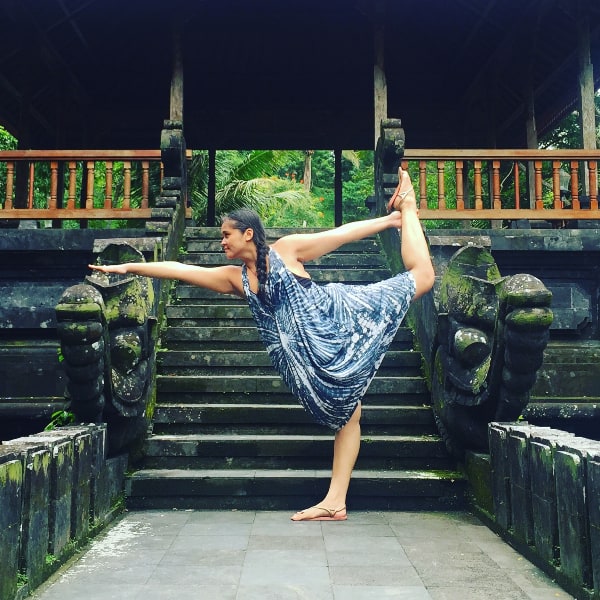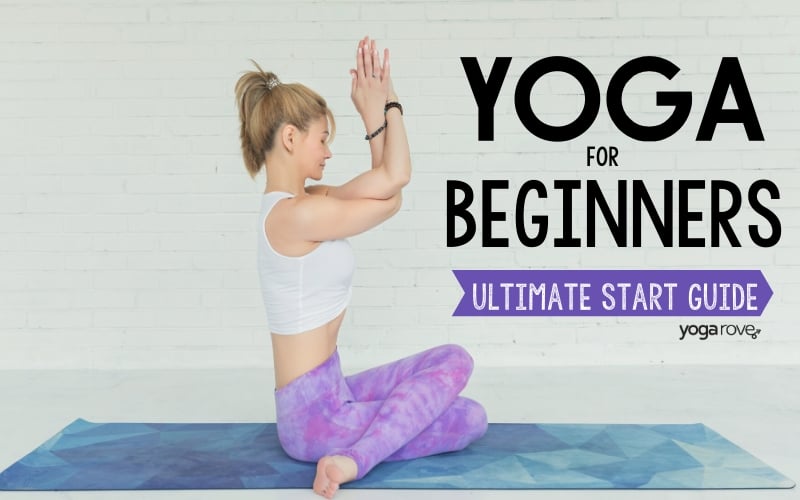This post may contain affiliate links. Please read our disclosure for more info.
A heart-opening and expansive posture, Camel pose, or Ustrasana mimics the shape of a camel’s hump. This posture opens up the front body, is a deep backbend, and can feel pretty amazing when you are in it. At the same time, Camel pose can be challenging to practice as it opens up the spine in a way that we, as humans, are not completely used to.
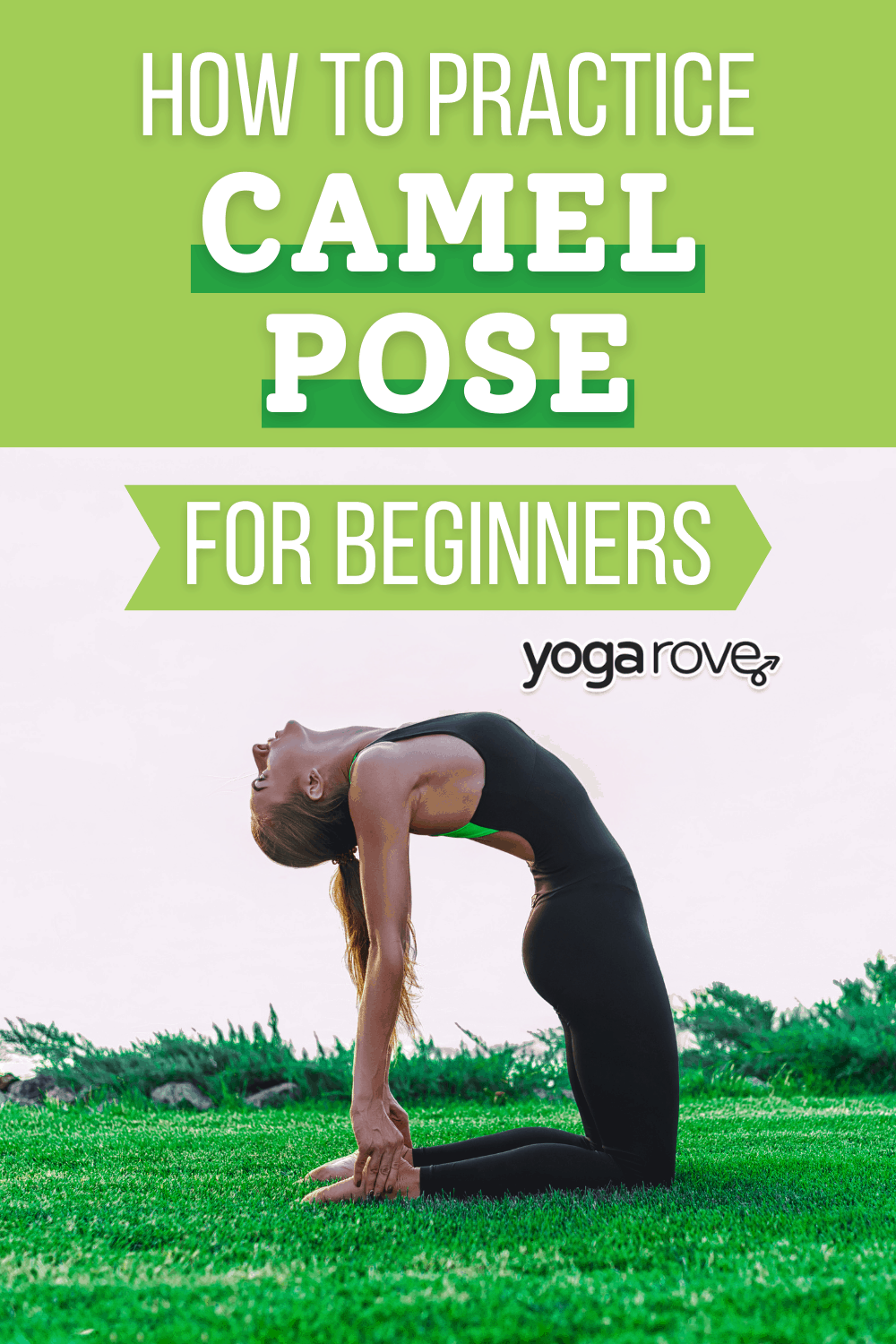
We are often hunched over desks, computers, or the car, and the backbend in camel leads to a very deep opening in the body. It is important to keep proper alignment while in the pose, and to be very conscious of your breathing. Camel pose is a wonderful posture to find space and openness in the body.
Benefits of Camel Pose
This amazing heart opener holds tons of benefits in your body. Some of them include:
- Stretches and opens your shoulders
- Opens your front body and chest
- Strengthens your core and your thighs
- Improves hip and spine flexibility
- Opens your hips
- Improves your spinal health and posture
- Helps with digestion and overall balance in the body
Warming Up for Camel Pose
Camel pose should always be practiced after you have adequately warmed up and opened the body. Often practiced toward the end of practice, Camel is practiced after standing poses and right before your restorative sequence. There are certain postures that may be helpful to practice before your Camel.
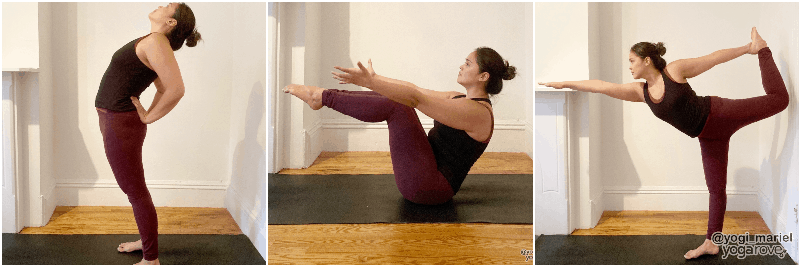
Standing Backbend
A Standing Backbend can help to engage your core and lower body and open up your chest before coming into Camel pose.
- Start at the top of your mat and take your feet apart hips-width distance. Keep your base strong with your feet rooting down to the mat.
- Place your hands at your lower back with your fingertips pointing up or down. Roll your shoulders up, back, and down and gently begin to lift your heart up toward the ceiling.
- At the same time, push your hips forward slightly as you squeeze your shoulder blades together. Keep your legs strong and lean back a bit more if you feel comfortable.
- Stay for 3-5 deep breaths.
Boat Pose
Boat pose engages your core, opens your thighs, and keeps your shoulders and chest open.
- Sit on your mat with your knees bent and your feet flat on the floor. Hold on to the backs of your knees and begin to lean back slightly.
- Lift your feet off the mat and take your shins parallel to the floor.
- Point or flex your feet, roll your shoulders back and down, lift your chest, and engage your core.
- You can keep your hands where they are or you can straighten your arms and reach your fingertips forward. Stay for 5 deep breaths.
Dancer’s Pose
This standing balancing pose is also a backbend and a great pose to practice before coming into Camel.
- Start at the top of your mat with your feet together. Lift your right foot off the mat, bend your knee, and take your heel to your butt.
- Reach back with your right hand and grab your right ankle from the inside, with your thumb to the baby toe side. Reach your left arm up, keeping your bicep by your ear and palm facing forward.
- As you inhale, lift up and as you exhale, kick your heel away from your body. Reach your left fingertips forward and take your arm parallel to the floor.
- Keep kicking and stretching and feel the backbend in your spine. Stay for 5 breaths and repeat on the opposite side.
How to Practice Camel Pose
If this is your first time practicing Camel pose, take your time. Focus on finding stability in your breath, as well as your body.
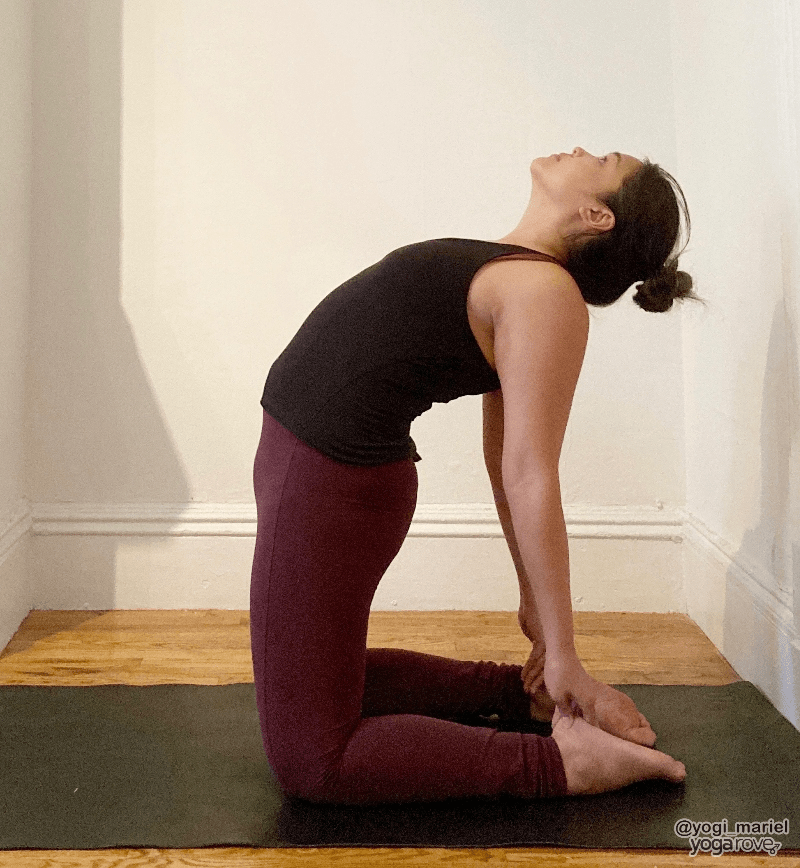
To practice Camel pose:
- Start at the center of your mat standing on your knees.
- Take your knees apart hips width distance. This is roughly the distance of two fists in between your knees.
- Check that your toes are pointing straight back and that your ankles are in line with your knees.
- Place your hands to your lower back, supporting the low back with your palms. You can take the fingertips to point up or down—whatever feels most comfortable.
- Roll your shoulders up, back, and down, and feel your shoulder blades squeeze down your back.
- Gently push your hips forward and start to lift your heart up toward the ceiling.
- Lead with your heart, keep your base strong, and open up your chest.
- Relax your head back without dropping the head completely. Your gaze can be at the ceiling or toward the back wall.
- Keep your hands at your lower back or if you feel comfortable, reach back to grab your heels.
- If you are grabbing your heels, keep your thumbs on the outside and fingertips on the inside. Keep your grip strong but try not to dump a lot of weight on heels.
- Slow down your breathing and stay for 5 deep breaths.
- To come out of the posture safely, use your hands to support your lower back.
Common Misalignments
It can be challenging to focus on your alignment during backbends, but it is crucial to remain safe and stable in the posture. Here are are few common misalignments:
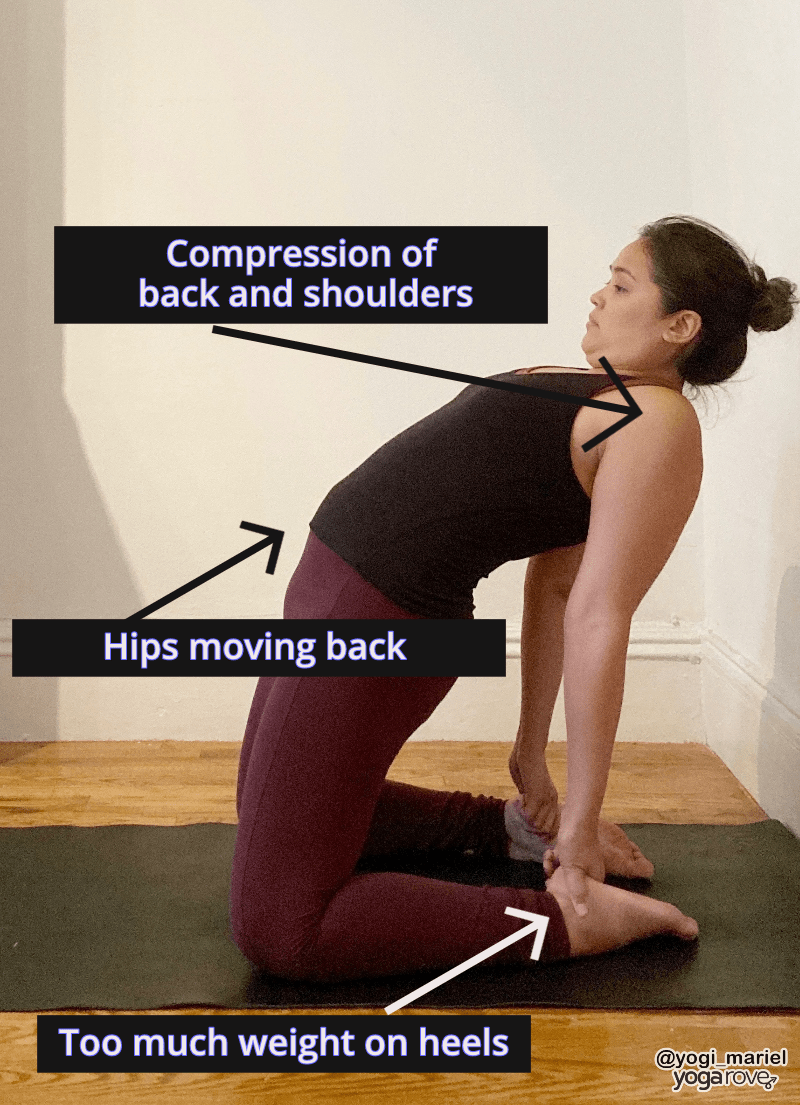
- Too much weight on heels: Make sure that your grip is tight but light if you are grabbing onto your heels. You want to feel expansive and open in the chest and often, if you are dumping the weight on your heels, the pose can contract, causing your hips to move back.
- Hips moving back: Keep your hips in line with your knees. This keeps your base strong and allows for strengthening of your lower body muscles and an opening of your front body. Push your hips slightly forward in Camel but make sure that your hips don’t go past your knees.
- Compression of lower back and shoulders: Keep your hips forward and your shoulders over or behind your heels to avoid compression. Compression in the lower back can cause pain or injury so work on finding more length.
- No back support: If cannot reach your heels, keep your hands at your lower back. The lack of support can cause injury, so make sure that you are supporting yourself with your strong core and with your hands. It is also important to support your back when coming out of Camel pose, as entering and exiting the pose incorrectly can often be the cause of injury.
Modifications in Camel Pose
You can modify Camel pose to make it feel more accessible for your body and your breath. Some tips are:

- Use your hands: Stay with your hands supporting your lower back until you feel comfortable enough to reach back for your heels. Try to stay in the pose for 5 deep breaths, using your hands as support, in order to open up your body.
- Shift your gaze: If it is uncomfortable for you neck, you can always continue to look forward or toward the ceiling while keeping your hands on your lower back for support.
- Use the wall: Practice against the wall by pushing your thighs and belly toward the wall.
- Support your knees: If you have sensitive knees, create a cushion for yourself by rolling up your mat or using a blanket under your knees.
Tips for Beginners
- Breathe: Camel pose can feel pretty intense because of the depth of the backend. This intensity can cause you to stop breathing or begin breathing in a very shallow and fast way. Regulate your breath in this pose. Slow down your inhales and exhales and work on finding comfort within any discomfort that you may feel.
- Lead with your heart: Instead of dropping your head back in order to see the wall behind you, let your heart lead this pose. Think of your heart lifting up toward the ceiling to open the chest, rather than focusing on seeing the back wall.
- Use your back body to open your front body: Squeeze your shoulder blades together to open your chest. Use your upper back to support the front body so that you can open your chest and shoulders.
Variations in Camel Pose
Once you feel comfortable in your Camel pose, try out these fun variations!
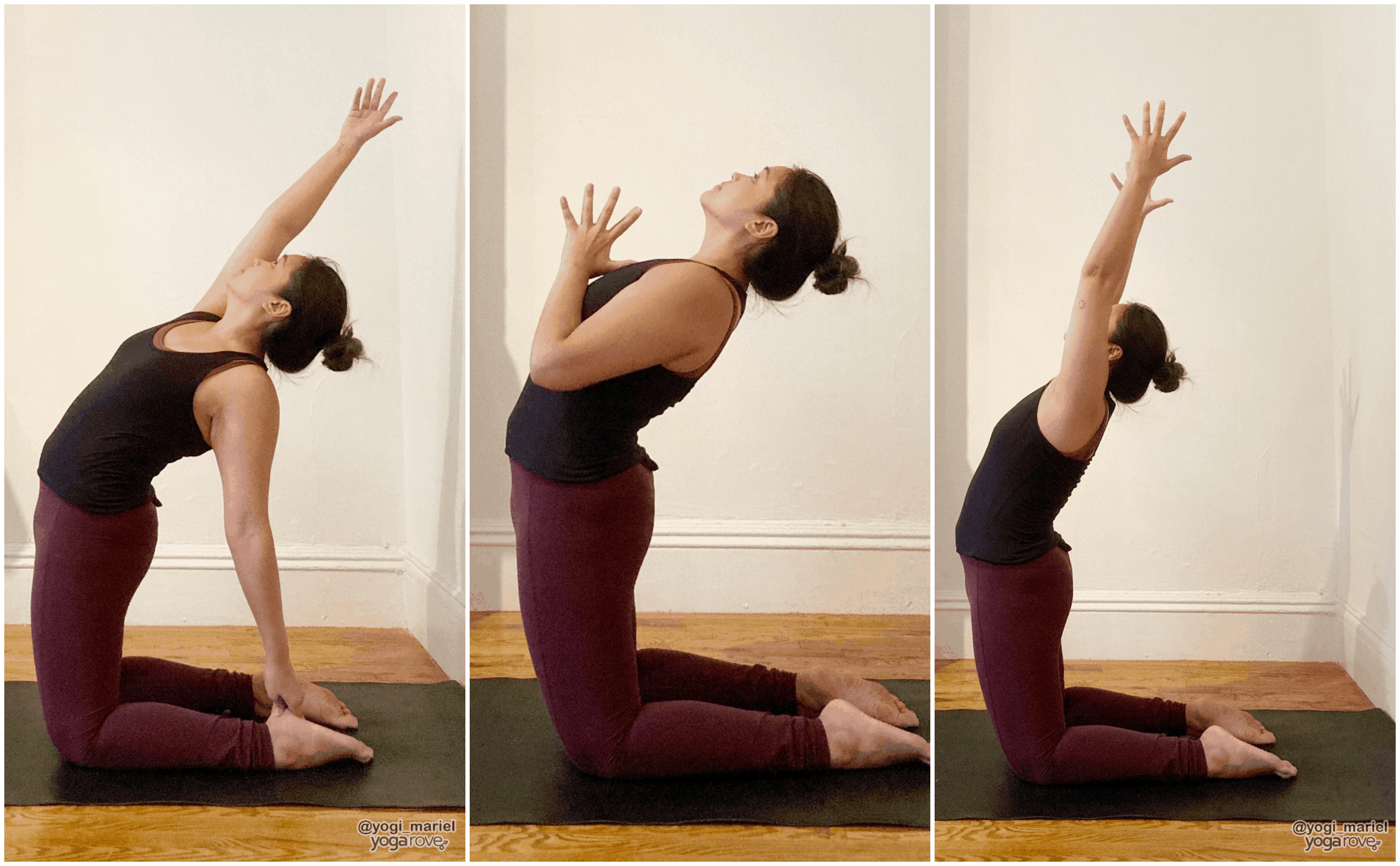
- Half Camel: Using one hand to support the lower back, stretch the other arm and reach your fingertips up and back. Keep the chest open and your collar broad as you engage the core and keep your lower body strong.
- Arm/ Hand Variations: If you know that you can keep your core engaged and your body in the proper alignment, you can choose to take your hands to heart center in a prayer position, or reach both of your arms up and back, keeping your biceps close to your ears an your chest lifted.
- One Legged: Keep one arm up overhead or reach for your heel. Bend your opposite knee and with the same hand, reach for the top of your foot with your elbow pointing upward. Gently pull your heel close to your sit bones as you keep your backbend.
Contraindications
If you have back, spine, or neck issues, take caution when practicing Camel. Depending on your body, it may be best to either modify or skip this pose altogether. If you suffer from migraines or vertigo, it may be best to look forward and use your hands to support your lower back. Take caution if you have high or low blood pressure and ask your yoga teacher for any modifications or tips.
It’s normal to feel a little dizzy, scared, or nervous when practicing Camel pose for the first time. But don’t let that stop you from taking a few breaths in this pose. Feel free to modify and use as many props as you need. Take your time to explore the posture and enjoy the journey of this beautiful backbend!


